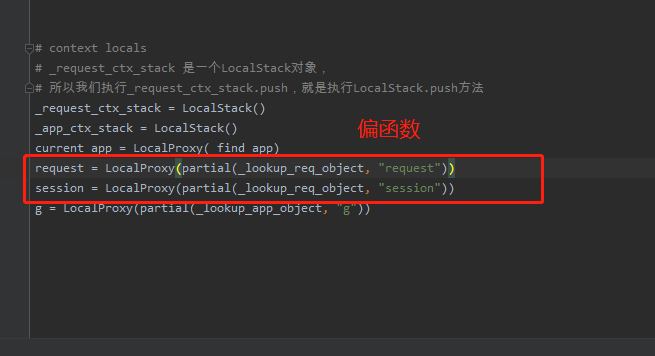flask的源码之请求
请求上下文
golbal文件,生成这些对象
_request_ctx_stack = LocalStack()
_app_ctx_stack = LocalStack()
current_app = LocalProxy(_find_app)
request = LocalProxy(partial(_lookup_req_object, "request"))
session = LocalProxy(partial(_lookup_req_object, "session"))
每一次有请求都会执行app.wsig_app(environ, start_response)
app.wsig_app源码:
def wsgi_app(self, environ, start_response):
# RequestContext的对象,其中包含当前请求的东西。
ctx = self.request_context(environ)
error = None
try:
try:
#RequestContext的对象,ctx.push,就执行是RequestContext对象的push方法
#ctx放入local中
ctx.push()
#请求扩展以及响应函数
response = self.full_dispatch_request()
except Exception as e:
error = e
response = self.handle_exception(e)
except: # noqa: B001
error = sys.exc_info()[1]
raise
return response(environ, start_response)
finally:
if self.should_ignore_error(error):
error = None
ctx.auto_pop(error)
ctx = self.request_context(environ)做了什么?ctx=RequestContext的对象,里面有请求相关等所有东西:
# 1 我们self.request_context(environ)执行是:所以ctx是RequestContext(self, environ)的返回值:
def request_context(self, environ):
#等一下返回的ctx就是RequestContext()执行的结果。
return RequestContext(self, environ)
#2 RequestContext(self, environ)的执行结果是什么?是RequestContext的对象,这个对象中包含了reuqest等信息
class RequestContext(object):
#app, environ,ctx,就是RequestContext的对象,
def __init__(self, app, environ, request=None, session=None):
self.app = app
if request is None:
request = app.request_class(environ)
self.request = request



ctx.push(),这里的ctx,是RequestContext的对象,
#1 ctx.push方法就执行RequestContext的对象的push方法:
#源码:
def push(self):
#当前的self是RequestContext的对象,也就是ctx,
_request_ctx_stack.push(self)
#2 _request_ctx_stack,我们发现它是全局LocalStack()的对象。
#_request_ctx_stack.push(self)就是执行LocalStack中的push方法,并且把ctx传给了#_request_ctx_stack.push的push方法。self=ctx
#LocalStack中的push源码:
def push(self, obj):
rv = getattr(self._local, "stack", None)
if rv is None:
#storage[线程,协程id]["stack"] = []
self._local.stack = rv = []
rv.append(obj)
return rv
#上述代码中的self._local是Local对象,用来保证数据安全。
#当代码执行self._local.stack = rv = [],再Local对象中的存储结构是:storage[线程,协程id]["stack"] = []
# rv.append(obj),把storage[线程,协程id]["stack"] = [obj],又由于obj=ctx,就算就是把ctx放入到Local对象中。结构如下Local().storage[线程,协程id]["stack"] = [ctx]







response = self.full_dispatch_request()
#1
#这句话我们执行是请扩展与响应函数
#再响应函数和请求扩展中就可以使用request,它是如果和实现的呢?
from flask import Flask,request,session
app = Flask(__name__)
def index():
print(request.method)
print(session)
return "ok"
#比如上面代码中request.method,是如何拿到请求相关的内容呢?
#2
#我们点进去看request是什么?
request = LocalProxy(partial(_lookup_req_object, "request"))
#我们发现request就是 LocalProxy的对象。
#那我们再LocalProxy应该能找到method属性,但是发现没有,既然没有,它就一定写了__getattr__
#我们看__getattr__的源码:
def __getattr__(self, name):
#request.method,现在的name就是method
if name == "__members__":
return dir(self._get_current_object())
#现在的name是method,self._get_current_object()执行结果就偏函数的执行结果
#偏函数的执行结果中来获取method
#偏函数的执行结果就是request.
#etattr(request, method)
return getattr(self._get_current_object(), name)
#3
#我们再看看_get_current_object()它的执行结果是什么?
#self._get_current_object()的源码:
def _get_current_object(self):
return self.__local()
#上面的self._get_current_object()执行结果就是self.__local()的执行结果
# 4
#self.__local是什么?
#我们发现这个self.__local是实例化的时候传递的,也就local,代码如下
def __init__(self, local, name=None):
#self.__local= _LocalProxy__local=local = partial(_lookup_req_object, "request")
#self.__local设置为隐藏属性,
object.__setattr__(self, "_LocalProxy__local", local)
# self.__local=local
#local是实例化的时候传递的。我们实例化这个 LocalProxy(partial(_lookup_req_object, "request"))
# 我们self._get_current_object=self.__local=local=partial(_lookup_req_object, "request")
#5
#那最终我们明白了:
def __getattr__(self, name):
#request.method,现在的name就是method
if name == "__members__":
return dir(self._get_current_object())
return getattr(self._get_current_object(), name)
#self._get_current_object() 执行结果,就partial(_lookup_req_object, "request")的执行结果。
#就是ctx.request,所以getattr(self._get_current_object(), name)相当于getattr(ctx.request, method)
#6
#partial(_lookup_req_object, "request")()执行的结果
#_lookup_req_object的代码如下:
def _lookup_req_object(name):
#这里的name,是"request"
top = _request_ctx_stack.top
#top是谁?是ctx.
if top is None:
raise RuntimeError(_request_ctx_err_msg)
#top里面找request,也就是top= ctx--》ctx里面找request.
return getattr(top, name)
# 7
#又因为_request_ctx_stack是LocalStack()的对象,所以 _request_ctx_stack.top就是执行LocalStack()的对象中的top:
#_request_ctx_stack.top的源码:
@property
def top(self):
try:
# storage[线程,协程id]["stack"] = [ctx]
#现在top的retrun值就ctx
return self._local.stack[-1]
except (AttributeError, IndexError):
return None
#代码中的self._local是Local对象,是我们存ctx的时候的Local对象。














Only you can control your future
You're not alone. You still have family,peopel who care for you and want to save you.

